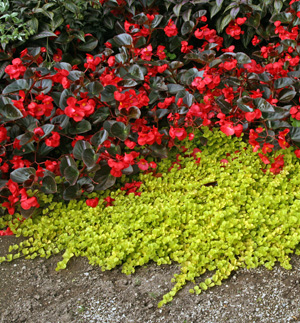 There are many species of Lysimachia that are used as ornamental plants. Golden creeping Jenny, the cultivar ‘Aurea’ of the low-growing species L. nummularia (= L. zawadzkii), can be a nice addition to containers or in other locations where its spread can be limited. This genus was traditionally placed in the primrose family (Primulaceae), and was reclassified a few years ago in the Myrsinaceae, but this family was recently redesignated as the subfamily Myrsinoideae in the Primulaceae – confused yet? – so it apparently is back where it started. This European species can be invasive (so planting the green type is not recommended), but the yellow cultivar is much less aggressive and suitable for judicious use in ornamental plantings. Other common names include moneywort, herb twopence, and occasionally creeping Charlie (not to be confused with the lawn weed Glechoma hederacea also commonly called creeping Charlie). This herbaceous perennial is hardy in zones 3-9 and was a winner of the Royal Horticultural Society Award of Merit.
There are many species of Lysimachia that are used as ornamental plants. Golden creeping Jenny, the cultivar ‘Aurea’ of the low-growing species L. nummularia (= L. zawadzkii), can be a nice addition to containers or in other locations where its spread can be limited. This genus was traditionally placed in the primrose family (Primulaceae), and was reclassified a few years ago in the Myrsinaceae, but this family was recently redesignated as the subfamily Myrsinoideae in the Primulaceae – confused yet? – so it apparently is back where it started. This European species can be invasive (so planting the green type is not recommended), but the yellow cultivar is much less aggressive and suitable for judicious use in ornamental plantings. Other common names include moneywort, herb twopence, and occasionally creeping Charlie (not to be confused with the lawn weed Glechoma hederacea also commonly called creeping Charlie). This herbaceous perennial is hardy in zones 3-9 and was a winner of the Royal Horticultural Society Award of Merit. 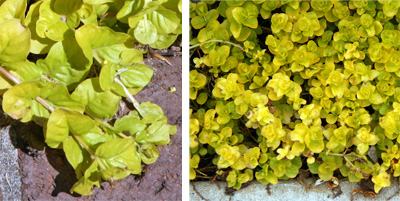 The creeping plants produce small, rounded leaves with wavy edges oppositely along the thin, trailing stems. The orbicular leaves are smooth and often shiny – resembling a string of small coins – with a few glandular black dots if you look closely. The almost-evergreen foliage of the cultivar ‘Aurea’ is yellow, ranging from lime green to soft chartreuse in shade, through golden yellow in partial or dappled shade, to a brassy gold in full sun (it may burn out in more southern areas in full sun), while that of the species is a soft green.
The creeping plants produce small, rounded leaves with wavy edges oppositely along the thin, trailing stems. The orbicular leaves are smooth and often shiny – resembling a string of small coins – with a few glandular black dots if you look closely. The almost-evergreen foliage of the cultivar ‘Aurea’ is yellow, ranging from lime green to soft chartreuse in shade, through golden yellow in partial or dappled shade, to a brassy gold in full sun (it may burn out in more southern areas in full sun), while that of the species is a soft green. 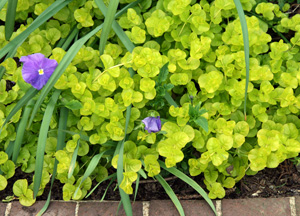 The stems grow vigorously, forming slender fibrous roots where leaf nodes come in contact with the soil. This creates a dense mat 2-4 inches tall growing chaotically in all directions. Single, bright yellow, cup-shaped flowers with are occasionally produced in the leaf axils. Each 1″ flower has 5 petals with dark reddish glandular dots, all set in a hairless green calyx with 5 triangular teeth shorter than the petals.
The stems grow vigorously, forming slender fibrous roots where leaf nodes come in contact with the soil. This creates a dense mat 2-4 inches tall growing chaotically in all directions. Single, bright yellow, cup-shaped flowers with are occasionally produced in the leaf axils. Each 1″ flower has 5 petals with dark reddish glandular dots, all set in a hairless green calyx with 5 triangular teeth shorter than the petals. 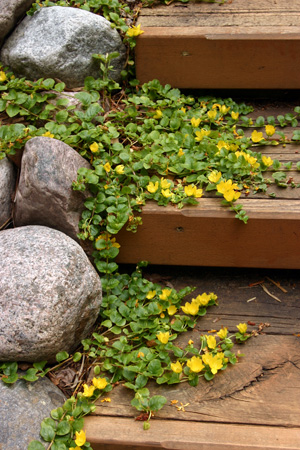
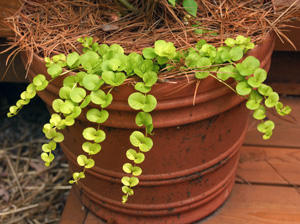 The plants bloom intermittently from early summer through fall, although this cultivar does not seem to bloom as consistently as the species (and sometimes forms just vegetative colonies that never bloom). Because the flowers are not dramatically different in color than the foliage, they are also not as conspicuous as on the green species. Seed capsules do not form readily, so ‘Aurea’ does not spread by seed as readily as the green type will. Use golden creeping Jenny carefully, to be sure it will not escape from cultivation or crowd out other plants in the garden. It makes a nice groundcover with tulips and daffodils, filling in the space once the bulbs’ leaves die back for the season. But it can overgrow other short plants, so situate it appropriately. It makes a nice underplanting beneath roses or other shrubs and around daylilies, ferns and tall perennials.
The plants bloom intermittently from early summer through fall, although this cultivar does not seem to bloom as consistently as the species (and sometimes forms just vegetative colonies that never bloom). Because the flowers are not dramatically different in color than the foliage, they are also not as conspicuous as on the green species. Seed capsules do not form readily, so ‘Aurea’ does not spread by seed as readily as the green type will. Use golden creeping Jenny carefully, to be sure it will not escape from cultivation or crowd out other plants in the garden. It makes a nice groundcover with tulips and daffodils, filling in the space once the bulbs’ leaves die back for the season. But it can overgrow other short plants, so situate it appropriately. It makes a nice underplanting beneath roses or other shrubs and around daylilies, ferns and tall perennials. 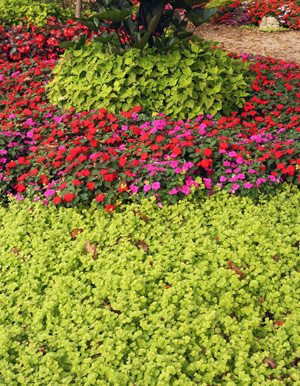 It makes a great contrast between dark-leaved plants, such as ‘Amethyst Myst’ or ‘Palace Purple’ Heuchera, or mingling with purple ajuga. Use it as a color echo with lady’s mantle (Alchemilla mollis) or a chartreuse or golden hosta such as ‘Sun Power’ or ‘Sum and Substance’ or a chartreuse cultivar of ornamental sweet potato (Ipomoea batatas). Use golden creeping Jenny as a trailing plant in containers, window boxes, or hanging baskets, or try planting it where it can cascade over a wall or bank. It can be used in ponds, water gardens, or marginal areas along waterways (as long as there is no danger of it escaping into natural areas) in shallow (up to 2″) water where it provides habitat for frogs, insects and small fish.
It makes a great contrast between dark-leaved plants, such as ‘Amethyst Myst’ or ‘Palace Purple’ Heuchera, or mingling with purple ajuga. Use it as a color echo with lady’s mantle (Alchemilla mollis) or a chartreuse or golden hosta such as ‘Sun Power’ or ‘Sum and Substance’ or a chartreuse cultivar of ornamental sweet potato (Ipomoea batatas). Use golden creeping Jenny as a trailing plant in containers, window boxes, or hanging baskets, or try planting it where it can cascade over a wall or bank. It can be used in ponds, water gardens, or marginal areas along waterways (as long as there is no danger of it escaping into natural areas) in shallow (up to 2″) water where it provides habitat for frogs, insects and small fish. 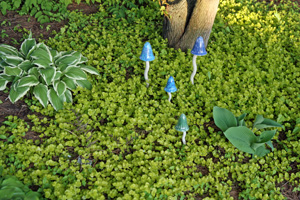 L. nummularia ‘Aurea’ can be planted almost any exposure from full sun to light shade, in moist soils. For the best color, situate the plant so it receives morning sun. It is rather shallow-rooted (so is fairly easy to dig out should it move into an area where it is unwanted), and does best with regular watering. It thrives in damp soils where other ground covers often cannot survive.
L. nummularia ‘Aurea’ can be planted almost any exposure from full sun to light shade, in moist soils. For the best color, situate the plant so it receives morning sun. It is rather shallow-rooted (so is fairly easy to dig out should it move into an area where it is unwanted), and does best with regular watering. It thrives in damp soils where other ground covers often cannot survive. 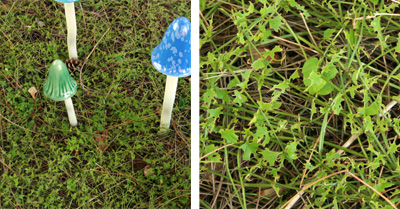 Creeping Jenny has few pests, although in some places slugs may attack the leaves and nearly completely defoliate the plants when high populations are present. The plants will look unsightly but the plants will usually survive. This plant is easily propagated by division (removing rooted chunks near the edge of a patch) or cuttings. It will readily root at nodes, so it may require persistent weeding to remove all of it from an area. – Susan Mahr, University of Wisconsin – Madison
Creeping Jenny has few pests, although in some places slugs may attack the leaves and nearly completely defoliate the plants when high populations are present. The plants will look unsightly but the plants will usually survive. This plant is easily propagated by division (removing rooted chunks near the edge of a patch) or cuttings. It will readily root at nodes, so it may require persistent weeding to remove all of it from an area. – Susan Mahr, University of Wisconsin – Madison
Will Creeping Jenny Kill Other Plants? How to Manage this Aggressive Grower
Creeping jenny, with its bright green leaves and cheerful yellow flowers, is a popular ground cover plant. However, its aggressive spreading nature also earns it a reputation as a thug that takes over gardens. So will creeping jenny kill other plants if left unchecked?
The short answer is yes, creeping jenny can potentially damage or kill its neighbors. But with diligent management, you can enjoy this plant without it conquering your entire garden. In this article, we’ll explore creeping jenny’s invasive traits and how to control it responsibly.
Overview of Creeping Jenny
Also called moneywort, creeping jenny (Lysimachia nummularia) is a low-growing perennial ground cover. It spreads via trailing stems that root at the nodes where they touch soil. Leaves are round and coin-shaped, leading to another common name of pennywort.
Native to Europe, creeping jenny flourishes in moist, partially shaded sites. Under ideal growing conditions, it forms a dense carpet of foliage and bears small yellow flowers in summer. While valued for its looks and hardiness, creeping jenny’s aggressively spreading nature is problematic.
How Creeping Jenny Can Harm Other Plants
Left unchecked, creeping jenny can absolutely kill or damage neighboring plants in your garden. Here are the main ways it accomplishes this:
Crowding Out – Creeping jenny’s dense mats overtake an area quickly, shading and starving other plants via monopolizing sunlight, nutrients, moisture and space.
Strangling – The plant’s stems put down roots wherever they touch soil. They sometimes grow over and around other plant stems, potentially girdling and strangling them.
Allelopathy – Some evidence suggests creeping jenny may release biochemicals that inhibit other plants’ growth. However, more research is needed to definitively prove allelopathic effects.
Pests/Disease – Thick mats of creeping jenny increase humidity and can harbor fungal diseases, slugs, and other pests that may spread to other plants.
So through direct competition and indirectly through attracting pests and diseases, creeping jenny can definitely contribute to the demise of less vigorous nearby plants.
How to Manage Creeping Jenny in Mixed Plantings
While creeping jenny demands close management, its attractiveness needn’t come at the expense of your other garden plants. Here are some tips to grow it responsibly:
-
Carefully site creeping jenny away from rare or fragile plants that can’t compete well. Give it ample space.
-
Use physical barriers like metal edging or thick plastic to contain creeping jenny and prevent it from invading planting beds.
-
Avoid overly fertile soil, which turbocharges creeping jenny’s spread. Light, sandy or gravelly soil helps slow it down.
-
Monitor the edges and promptly remove rogue shoots encroaching on less vigorous neighbors.
-
Allow plants like ivy, vinca, or liriope that can hold their own to grow near creeping jenny as competition.
-
Prune back the most aggressive sections in spring and fall to curb expansion and prevent encroachment.
-
Consider judicious spot applications of herbicide on particularly robust patches, taking care not to harm other plants.
Vigilance and persistence are critical to allow creeping jenny without it running rampant through your garden. But the effort pays off in enjoying its durability and beauty without sacrificing diversity.
Better-Behaved Alternatives to Creeping Jenny
For gardeners not inclined to constantly battle creeping jenny, there are several better-behaved alternatives that offer comparable appeal:
-
Sweet woodruff has fragrant white spring flowers and thrives in shade like creeping jenny but is slower to spread.
-
Creeping phlox, also called moss phlox or moss pink, is a native ground cover with pretty spring blooms that spreads gently.
-
Irish moss forms a soft, mossy carpet of greenery or chartreuse that tolerates foot traffic once established.
-
Bugleweed (Ajuga) offers colorful spikes of blue flowers on a low mat of foliage, spreading less aggressively than creeping jenny.
-
Mazus reptans stays compact with soft mats of small leaves topped with cheerful blue and white blooms.
-
Lobelia siphilitica makes a well-behaved ground cover with vivid blue late-summer flower spikes.
These and other choices provide creeping jenny’s benefits without its ruthless expansion. Shop around to find an appealing alternative if you don’t want to fight constant containment battles.
Key Takeaways About Growing Creeping Jenny
Here are the key points to remember if you plan to grow creeping jenny:
-
Site it carefully and give it adequate space to avoid overtaking precious specimens. Use barriers to confine it.
-
Prune frequently – at least twice yearly – to curb its spread. Be prepared to dig out and remove encroaching stems.
-
Allow competitors like ivy or vinca minor to grow nearby to help keep it in check naturally.
-
Amend soil with sand or gravel to lighten texture, promoting drainage and discouraging lush growth.
-
Monitor closely for new shoots around edges. Stop expansion promptly before creeping jenny invades planting beds.
-
Consider judicious spot applications of herbicide on particularly robust patches if manual removal proves insufficient.
While it demands attentive management, creeping jenny’s appeal can enhance your landscape without turning it into a creeping jenny monoculture. Just be prepared to put in the effort to keep it controlled.

Ask Your Gardening Question
If you’re unable to find the information you need, please submit your gardening question here:
Featured Articles by Season




Great Groundcover: Creeping Jenny Golden – Lysimachia nummularia ‘Aurea’
FAQ
What are the cons of Creeping Jenny?
The main problem most people have with creeping Jenny is that it spreads. It is considered an invasive plant in many places and may not be available at your local nurseries.
What can you plant with Creeping Jenny?
Creeping Jenny Companion Plants
Grow a creeping jenny groundcover with bulbs like tulips and daffodils, under roses, or around catmint, daylilies, hydrangeas and ferns.
Should I remove Creeping Jenny?
Non-chemical Management
If Creeping Jenny is established in your lawn it may take two seasons to eradicate it. The plant can be hand pulled where practical. All stems and stem fragments should be removed from the area to prevent the stems from rooting again in the soil.
Does creeping thyme choke out other plants?
Creeping thyme can help suppress weeds due to its dense, mat-forming growth habit, but it’s not typically aggressive enough to choke out other established plants, especially taller ones.
Can creeping jenny kill plants?
The short answer is yes – creeping Jenny can potentially kill or damage nearby plants in several ways: Crowding out – By quickly forming dense mats, creeping Jenny blocks sunlight and monopolizes nutrients needed by other plants. Strangling – The stems root wherever they touch soil, sometimes encircling and strangling other plant stems.
How do you get rid of creeping jenny?
If the plant is established in your yard, it may take two growing seasons to eradicate it. The best method of creeping jenny control is a combination of physically removing the plant and applying herbicides. Dig up every new plant you find and spray an herbicide. New plants will emerge every few weeks – so keep pulling them up and spraying.
Are creeping jenny invasive?
Here we dig into the plant’s invasive traits and best practices for protecting other flora. Known botanically as Lysimachia nummularia, creeping Jenny is a low-growing perennial ground cover that spreads via creeping stems that root at nodes Its round, coin-shaped leaves give rise to its other common name – moneywort
Can a weed grow near a creeping jenny?
Succulents, for example, will not thrive near creeping jenny. This is because the weed’s roots retain water, which can create a damp environment around the other plants, leading to root rot. Additionally, plants with shallow root systems or more delicate foliage are more likely to be harmed by creeping jenny.
How does creeping jenny affect plants?
One significant impact of Creeping Jenny’s proliferation is its effect on native grasses and other plants. It competes for resources – such as light, water, and nutrients – often winning out due to its dense growth habit. A Warning
Do creeping jenny plants outcompete other plants?
This enables the plant to outcompete other plants by occupying the available resources, such as water, nutrients, and light, that other plants need to thrive. In addition, creeping jenny has a unique adaptation that allows it to grow even in wet soil conditions, which make it an ideal plant for gardens with poorly drained soils.
